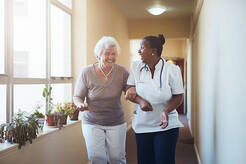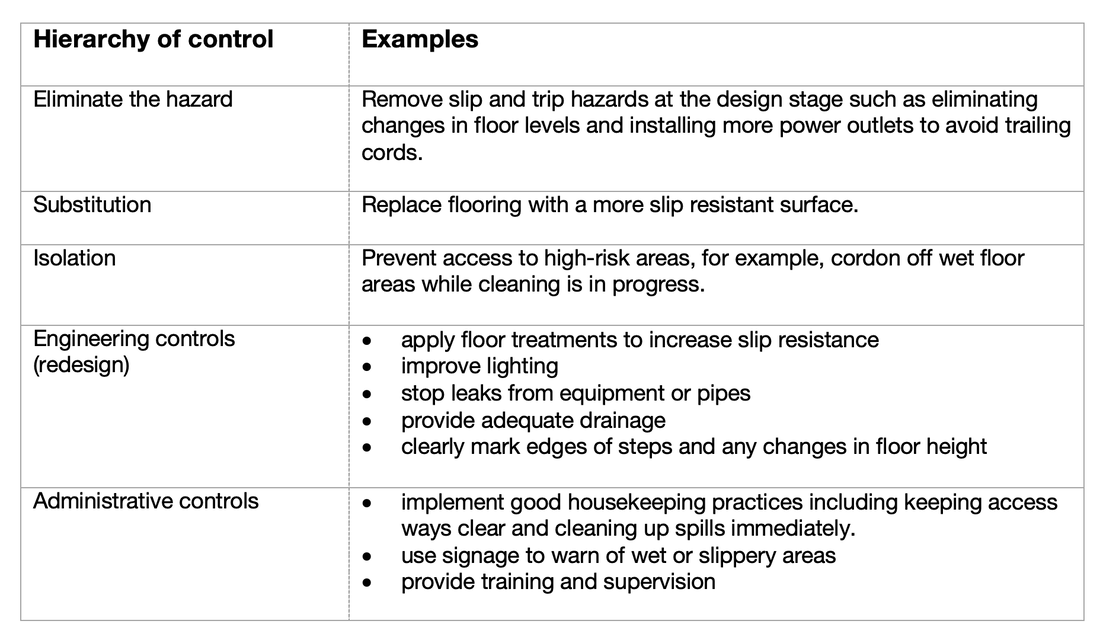|
How flooring design contributes to healthy supportive aged-care environments ‘Safety isn’t expensive, it’s priceless” - Anon Aged Care NZ Issue 01 2022 .  Slips and falls lead to thousands of injuries in New Zealand every year, with flooring surfaces playing a major part in many of these incidents. Assessing the risks and choosing flooring products that are slip-resistant and suitable for each application is therefore paramount for the designer and management team as it ensures the safety of users and a reduction to the risk level and likelihood of litigation. When it comes to choosing products to be part of an aged care facility, the right products ensure a better, safer and cleaner environment for all who utilise the facility. Flooring contributes to the design of healthcare facilities in a multitude of ways, contributing aesthetically to the overall look and feel of a facility, providing comfort for patients and staff, and working as a way-finding tool to designate areas. At the same time, the flooring palette has to take into account the demands of each space. The best way to approach these design areas is to decide on a style, such as a clinical or relaxed environment, and research colour trends and how colours affect emotion especially within mental health. Designers need to consider the lifestyle, the overall feel required in the project, research products that are fit for purpose and that will provide sustainable slip resistance where required, the abrasion level of the flooring and wear layers, the ease of cleaning and ongoing cleaning and maintenance costs. Ultimately a product is usually selected based on whether it is ‘fit for purpose’ or not. Surfaces with a raised profile or heavy texturing, for example, should not be used in areas where wheeled traffic is expected, but it is recommended for floor safety in areas such as central kitchens and wet areas. From floors that stand up to frequent spills, to an option that is adhesive-free, flooring products should be thoroughly tested to ensure that they meet the needs of different spaces in a healthcare or aged care project.  Slips and trips Slips occur when a person’s foot lose traction with the ground surface due to wearing inappropriate footwear or when walking on slippery floor surfaces such as those that are highly polished, wet or greasy. Trips occur when a person unexpectedly catches their foot on an object or surface. In most cases people trip on low obstacles that are not easily noticed such as uneven edges in flooring, loose mats, opened drawers, untidy tools or cables from electrical equipment. Falls can result from a slip or trip but many also occur during falls from low heights such as steps, stairs and curbs or from an uneven surface in the flooring. Selecting control measures – design of facilities The best way to eliminate slips and trips is to build and design facilities with safety in mind. The following should be considered during the floor design stage:
The role of PCBUs PCBUs must manage the health and safety risks associated with slips and trips by eliminating the risk so far as is reasonably practicable, and if that is not reasonably practicable, minimising the risk so far as is reasonably practicable. This involves a systematic approach to:
There are various ways to control the risk of slips and trips, listed below in order of their effectiveness (known as the hierarchy of control). More than one control measure may be needed to provide the best protection. Identifying slip and trip hazards Common slip hazards include:
Common trip hazards include:
Controlling the risks of slipping Floor treatments that improve slip resistance are those that increase the surface roughness of the flooring. The main floor treatments are sand blasting or grinding, chemical etching, coating with resins and using floor mats or adhesive anti-slip strips. Examples of different floor types that may be suitable in an aged care setting include: In addition to ensuring the best flooring options, when selecting and purchasing footwear – both for residents and staff – consider whether it has good slip resistant properties, in addition to any other required safety features. For example:
Carers and staff in aged care environments, both at aged care facilities and in homecare situations, owe a duty of care to the individuals under their care. This means that choosing a safe flooring solution is an important consideration when designing a building in aged care environments. When it comes to choosing products to be part of a hospital facility or an aged care facility, the right products are going to ensure a better, safer and cleaner environment for all who utilise the facility. 10 Ways to Love your Brain Start now. It’s never too late or too early to incorporate healthy habits Growing evidence indicates that people can reduce their risk of cognitive decline by adopting key lifestyle habits. When possible, combine these habits to achieve maximum benefit for the brain and body.  Break a sweat Engage in regular cardiovascular exercise that elevates heart rate and increases blood flow to the brain and body.  Hit the books Formal education will help reduce risk of cognitive decline and dementia. Take a class at a local college, community centre or online.  Butt out Evidence shows smoking increases risk of cognitive decline. Quitting smoking can reduce risk to levels comparable to those who have not smoked.  Follow your heart Risk factors for cardiovascular disease and stroke – obesity, high blood pressure and diabetes – negatively impact your cognitive health.  Heads up Brain injury can cause risk of cognitive decline and dementia. Wear a safety belt and use a helmet when playing contact sports or riding a bike.  Fuel up right Eat a balanced diet that is higher in vegetables and fruit to help reduce the risk of cognitive decline.  Catch some Zzz’s Not getting enough sleep due to conditions like insomnia or sleep apnoea may result in problems with memory and thinking.  Take care of your mental health Some studies link depression with cognitive decline, so seek treatment if. You have depression, anxiety or stress.  Buddy up Staying socially engaged may support brain health. Find ways to be part of your local community.  Stump yourself Challenge your mind. Build a piece of furniture. Play games of strategy, like bridge. 10 Ways to love your brain Start now. It's never too late or too early to incorporate healthy habits Ref: Alzheimer’s Association NZ
Aged care providers share COVID lessons  The Aged Care Quality and Safety Commission has published a report of the key takeaways and lessons learned from 34 aged care providers who experienced an outbreak in at least one of their residential services in Victoria, Australia. The 42-page report is based on interviews with CEO’s, senior managers and board chairs that aimed to understand what providers learned before, during and after the outbreaks, what they are doing differently as a result of their experience and the roles other parties played in responding to the outbreaks. The report covers planning, governance, human resources, care and service delivery, infection control and communications. The sections on human resources and infection control have the most learnings. Among them is the need to better know staff including their domestic arrangements and ability and willingness to work onsite during an outbreak. ‘Many providers felt they did not have a good understanding of their staff’s individual circumstances or their capacity to work during an outbreak and described having a better understanding of their workforce since experiencing an outbreak,’ the Aged Care Quality and Safety Commission found. Providers also faced challenges with staff who were furloughed, which means stood down because they were potentially exposed to a person with COVID 19. To help overcome these challenges, providers said they worked with staff to suit their needs. This included identifying what was needed to enable staff to work during an outbreak, facilitating staff to work remotely if possible and accommodating staff who were covid positive or working with covid positive residents in hotels to mitigate concerns of transmitting the virus. ‘Providers also said they would make emotional and mental health support available to staff early, noting that they were working under conditions of extreme stress and were susceptible to burnout,’ the report said. Infection control procedures Aged care providers identified effective infection prevention and control planning as important, but many said they felt unprepared for the intensity and complexity of the reality despite being familiar with infection prevention and control procedures. ‘Many providers described that, in hindsight, they would have provided more infection control training earlier for staff across the services,’ the report said. It was also necessary to frequently provide ongoing infection control training to reinforce messages and minimise complacency. Having staff demonstrate infection control measures such as hand hygiene before working on the floor, a train-the-trainer approach to distribute knowledge, checklists and instruction videos to support staff with limited English are among strategies identified to address the challenges. ‘Since experiencing outbreaks providers continue to focus on infection control by prompting infection prevention champions, employing infection control leads, providing ongoing training and communications to all staff on site, undertaking hygiene spot checks and increasing the amount of hand hygiene stations, PPE stations and clinical waste bins,’ the report said. Delivery of care Providers faced several challenges delivering care during an outbreak that were escalated when staff were furloughed, and other workers were brought in. As a result, providers recognised the importance of being able to quickly identify residents and their care needs. For some providers this involved using wristbands, photos and laminated printouts of key documents, such as resident profiles and care plans, placed inside residents’ rooms or on walls or doors, according to the report. ‘Having simplified documents, checklists and charts available at the point of care made staff and residents alike feel more confident in the delivery of care and services,’ it said. Food services Some providers had not thought about how essential services such as food would be managed in an outbreak and some had underestimated the additional time these tasks would take, the report said. To overcome these challenges, providers said they needed more than one back up contractor to ensure food services were maintained during the outbreak.  'Providers also highlighted the importance of ensuring contracts had systems in place to maintain a high standard of infection control, and that contractors should be included in all infection control communications and training to ensure a consistent approach across the services,’ the report said. It is also important to provide clear step-by-step instructions to all staff involved in preparing and delivering food to ensure appropriate infection control is maintained, providers said. ‘Providers found they had to plan every detail of how food would be moved throughout the service to prevent potential contamination across different residents and areas of the service.’ It was also important to ensure kitchen staff were trained and educated. For one aged care provider, they made their infection control nurse available to contactors to advise on safe food handling procedures and answer questions. Other key learnings It is critical to:
From: Aged Care NZ Issue 02 2021 Osteoporosis – not just a woman’s disease  ‘Only women get osteoporosis, right?’ Not quite. At least one in five Kiwi men will break a bone because of osteoporosis and when men get a hip fracture, they’re more likely to require care in a long-term facility. Even worse, 37% of men who get a hip fracture will die within a year after the accident. It shouldn’t be this way. One of the biggest issues is that people simply don’t know that men are also at risk of this disease. In fact, men are less likely to be assessed or receive treatment for osteoporosis after they’ve broken a bone. It’s incredibly important that men know they’re at risk of this disease. The good news is, it’s never too late to start taking action for your bones Here are three ways men (and women) can help minimise the risk of osteoporosis. 1. Maintain a healthy body weight If you have lower body weight, you’re more likely to have less bone issues. Also, if you’re older, having low body weight will mean you have less fat padding around the hips, taking away a nice cushion to minimize the impact of all fall. So, make sure you eat a balanced nutritional diet, and maintain a healthy body weight. 2. Quit smoking Smoking slows down the cells in your body that build bone health. If you’re a smoker, try to decrease how much you smoke, or quit entirely so that your bones can stay healthy. 3. Don’t drink as much alcohol This is also a tough habit to break. But alcohol affects the cells that build and break down bone. Too much alcohol can also make you unsteady on your feet, making you more likely to trip, fall and break a bone. Try to decrease your alcohol intake. Seriously your bones will love it. 4. Exercise Most importantly if you or the men in your life have broken a bone following a simple trip or fall since you turned 50, you are twice as likely to break another bone in the future. And, if you would like to learn more about how to improve your bone health, please visit the website www.knowyourbones.org.nz  If you need help to gain weight or want an exercise programme that is right for you, just contact Therapy Professionals Ltd phone: 03 377 5280 or email: [email protected]. Our friendly therapists can help. From: Keeping on August 2023 Tips for keeping your home warmer and drier in the colder months  As the temperatures drop, and the colder months start to set in, many of us are looking for ways to stay warm and cosy at home without breaking the bank. Fortunately you can take several easy steps to keep your home warmer and drier during the colder months. Here are some tips from Christchurch Charitable Trust Community Action (CEA) to help you get started. Use good quality curtains One of the easiest ways to get free heat is by opening your curtains in the morning to let the sun in and closing them at dusk to trap the heat in. This helps regulate your home’s temperature and reduce your heating bill. You can visit CEA’s Curtain Bank for free thermal lined recycled curtains. Curtains can be made to your specific measurements and there are no qualifying criteria. For more information, visit wwww.cea.co.nz/curtains/. Try not to dry clothes inside Dying your clothes in poorly ventilated rooms during winter could make your house damp and lead to mould growth. If possible, use a dryer or hang clothes outside on a day when it isn’t raining. If this isn’t possible, try to keep a window open or use a dehumidifier. Keep an eye on condensation that may develop on windows. Wipe condensation Moisture can build up on your windows, and as the day heats up the moisture will evaporate into your house and lead to dampness making it harder to heat your room. To prevent this, wipe condensation off your windows every morning and invest in a squeegee or a ‘Scoopy’ to catch it. You can purchase a Scoopy at www.cea.co.nz/shop/ Ventilate your home It is essential to ventilate your home daily, even in winter. Open windows on opposite sides of your house for at least 10 minutes each day to allow fresh air to circulate.  Use your heat pump wisely If you’re using a heat pump to heat your home this winter, be mindful how long you have it on and at what temperature. It is recommended that during the colder months you set your heat pump to around 18-22 degrees, and only use it in the rooms that need heating. Although this seems low, having it on a higher setting won’t actually heat up your room any faster. It’s not wise to leave your heat pump on all day either. If you can, schedule your heat pump to activate 15 minutes before you get home. Assess your heating Depending on your home’s layout and insulation, radiant heat (bar heaters, log burners) may be more efficient than convection heat (fan heater, oil column heater). Contact CEA heating experts for advice on how to best heat your home with the resources you have.  Use dry firewood If you’re using a log burner, only use dry firewood to prevent excess moisture build up. Use cold water for washing Hot water can account for up to 30% of your power bill. Try to use more cold water to wash clothes and dishes and take shorter showers in winter. Keep furniture away from external walls To prevent mould from growing, keep a gap between your furniture and external walls. Use a double-door sausage
Use a double-door sausage that moves with the door to prevent drafts between heated and unheated parts of your home. You can purchase one at www.cea.co.nz Keep doors closed Keep the doors closed to your bathroom, kitchen and laundry shut to reduce condensation and dampness in these areas. Avoid using unflued gas heaters These heaters can emit up to one litre of moisture every hour, leading to dampness in your home. They are also expensive to run and can release dangerous gasses, so always use them with a window open and preferably only use them in emergencies. By following these simple tips, you can keep your home warm and dry during the colder months while saving money on your heating bills. You may be eligible for 80-100% subsidised insulation. As a charitable trust, CEA can provide subsidised funding to eligible homes with assistance from the Warmer Kiwi Homes programme. Get in contact with them for more information and to check your eligibility. www.cea.co.nz or 0800 438 9276 Ref: Keeping on August 2003 |
AuthorShonagh O'Hagan Archives
July 2024
|




 RSS Feed
RSS Feed